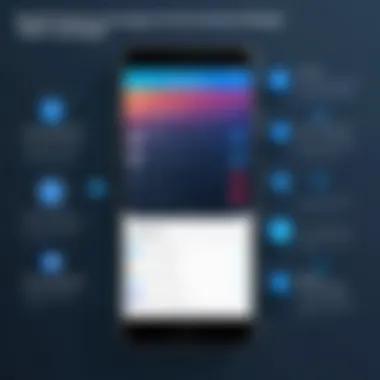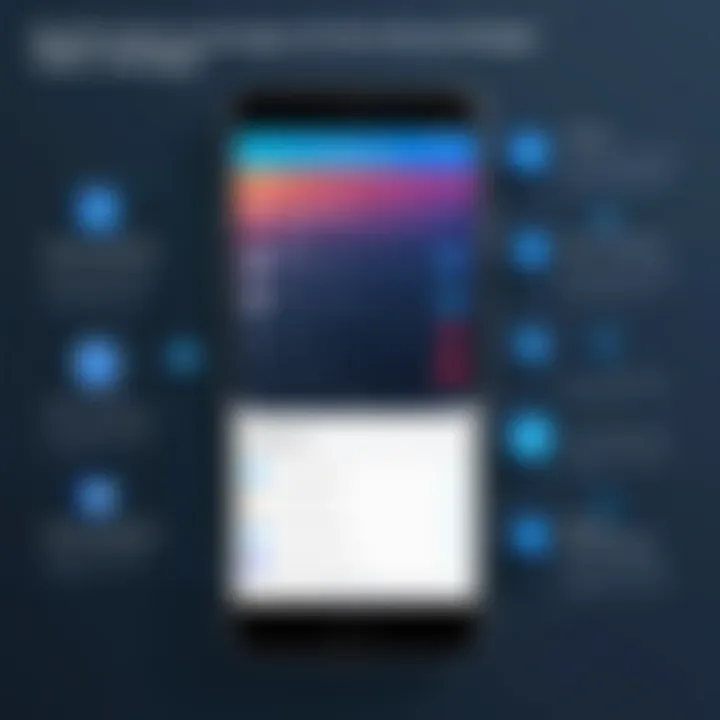Understanding Caller ID Announcer Apps for Users


Intro
In an age of rapid technological advancement, mobile communication plays an essential role in both personal and professional spheres. Among various innovations, caller ID announcer apps stand out for their crucial functionality. They enhance the ability to communicate effectively, particularly for people who have visual impairments or those who need hands-free solutions.
These apps do more than just display the caller's number. They inform the user about who is calling them audibly, allowing individuals to prioritize their responses or even avoid unwanted calls without having to look at their devices. This growth in technology emphasizes the need for tools that are inclusive and supportive of all users. With such an array of options available on the market, understanding the core functionalities, key features, and overall benefits of these apps is vital for making an informed decision.
In the following sections, we will delve into the primary functionalities of these applications, break down their features, and explore their specifications to guide users in choosing the most suitable app based on their requirements.
Prolusion to Caller Announcer Apps
Caller ID announcer apps constitute a significant advancement in mobile technology. They enhance the way users interact with incoming calls, combining functionality with user-centric design. These applications are especially beneficial for people who experience visual impairments. Additionally, users engaged in multitasking find these tools essential for maintaining communication without needing to focus visually on their devices. The relevance of caller ID announcer apps cannot be overstated in today’s fast-paced environment, where hands-free operation is often required.
Definition and Purpose
Caller ID announcer apps are software applications designed to vocalize information about incoming calls. When a call comes in, the app audibly announces the caller's name or number, helping users identify who is calling without looking at the screen. This is especially useful for individuals who may have difficulty seeing their devices clearly or those who are driving. The primary purpose of these apps is to improve accessibility and convenience, fostering communication in various situations.
Historical Context of Caller Technology
The concept of Caller ID technology originated in the 1980s. Initially, it allowed users to see the incoming number on their telephone displays. As mobile devices gained popularity, the capability evolved, and eventually caller ID announced features became accessible in various smartphone applications. The development of caller ID announcer apps marked an important turn. They not only provide a visual representation of incoming calls but also convert that information into audible announcements. This evolution reflects a broader trend in technology—making communication more inclusive and user-friendly.
Key Features of Caller Announcer Apps
The key features of caller ID announcer apps are critical in understanding their utility and how they enhance user experience. These apps significantly improve communication dynamics for a range of users, particularly those who may have visual impairment or desire hands-free operation. Their functionalities directly affect accessibility and ease, making it essential to recognize these elements for informed choices.
Voice Announcements
Voice announcements represent a cornerstone feature of caller ID announcer apps. This functionality allows users to hear the name or number of incoming callers audibly. The clarity of these announcements can be particularly valuable in ensuring that users can identify callers without needing to look at their screens. Hearing who is calling can not only reduce frustration but also enable users to make swift decisions about answering or ignoring calls. The technology behind these voice recordings needs to be robust, ensuring sound quality is clear and distinct, regardless of surrounding noise.
Customization Options
Customization options are another significant aspect when selecting a caller ID announcer app. They allow users to tailor the app’s functionalities to meet personal preferences and needs. Here are some particular sub-features of customization:
Selecting Voices
Selecting voices in caller ID announcer apps enhances user engagement by providing options that can fit personal preferences. Users can often choose from various voice profiles, each with distinct tones and characteristics. The diversity of voice selections contributes to a more personalized experience, making app usage more enjoyable. A unique aspect of this feature is the localization of voices, which allows users to select voices that align with regional accents or language preferences. This enhances relatability and user comfort. However, a potential disadvantage might be that not all voices are equally clear, which can affect recognition accuracy.
Adjusting Volume Levels
Adjusting volume levels is an indispensable feature that allows users to set the announcement volume to a comfortable level. It helps maintain a clear distinction between the caller’s announcements and ambient noise. The ability to adjust this setting is crucial, especially in environments with varying sound levels. The unique feature of this option is that users can often set different volumes for different scenarios, like public settings versus private spaces. However, over-adjusting may lead to missed announcements or annoyances during quieter moments.
Personalized Ringtones
Personalized ringtones serve to further individualize the caller experience. Users can assign specific sounds to particular contacts, providing auditory cues that identify who is calling even before listening to a voice announcement. This feature adds an extra layer of usability. It can help foster a sense of belonging or familiarity. Such selection can also differentiate important calls from mundane ones at a glance. The challenge with this feature is ensuring the custom ringtones do not inadvertently clash with default alerts from other apps, potentially causing confusion.
Integration with Contacts
Integration with contacts is a vital capability of caller ID announcer apps. This functionality allows the app to access the user’s contact list, providing the necessary information for accurate announcements. Effective integration ensures that the names of known contacts are pronounced correctly, which helps users avoid additional confusion caused by unknown numbers. It also fosters a sense of reliability and trust in the application. A shortcoming of this feature may include privacy concerns about sharing contact information with the app. Users need to assess the level of data access they're comfortable providing.
Benefits of Using Caller Announcer Apps
Caller ID announcer apps have gained notable traction in recent years, offering a range of advantages to users. These benefits extend beyond mere caller identification, enhancing user experience significantly. In this section, we will delve into the crucial points of accessibility, convenience, and improved identification, underscoring their importance in everyday communication.
Accessibility for Visually Impaired Users


For individuals with visual impairments, the ability to identify callers can significantly impact daily life. These apps provide an invaluable service that transforms how visually impaired users interact with their devices. The vocal announcements of incoming calls ensure users can recognize who is calling without needing to rely on screen prompts. This is especially critical in preventing missed calls and maintaining social connections.
The effectiveness of these apps often combines with the phone’s accessibility features. Users can customize voice settings to suit their preferences, making the experience personal and user-friendly. Integration with voice-controlled devices adds another layer of accessibility, allowing for hands-free operation, which is essential for those who may face challenges in multitasking.
Increased Convenience for Hands-Free Use
In an era where multitasking is a norm, hands-free operations have become vital. Caller ID announcer apps deliver this convenience effectively. Instead of needing to glance at a device, users can listen to announcements. This ability is particularly beneficial while driving or engaging in other tasks where visual attention isn't possible.
The app enables users to remain informed about incoming calls without interruption. Customization options further enhance this utility. Users can tweak settings such as volume and voice types to align with their environments, making it adaptable to various situations.
Enhanced Caller Identification
Identifying callers correctly is crucial in improving communication efficiency. Caller ID announcer apps come equipped with features that streamline this process. They provide information not only on the caller’s number but also link to saved contacts, delivering names and relevant information directly. This is particularly useful for distinguishing between known contacts and potential spam calls.
Moreover, many apps incorporate additional data, such as location and caller type, helping users to make informed decisions on answering calls. This element can help minimize unwanted interruptions and enhance personal and professional communication.
"Caller ID announcer apps revolutionize how users identify and manage incoming calls, creating a more seamless experience."
In summary, the benefits of using caller ID announcer apps are multifaceted. They offer significant accessibility for visually impaired users, increase convenience for tasks demanding hands-free operation, and improve caller identification accuracy. Each of these aspects plays a critical role in making communication clearer and more manageable.
Limitations and Drawbacks
While caller ID announcer apps offer many benefits, it is essential to consider their limitations and drawbacks. Understanding these aspects provides a more balanced view of how these apps function in real-world scenarios. By exploring drawbacks, users can make informed decisions that align with their needs and priorities.
Reliability of Caller Identification
Caller identification is a fundamental feature of these apps. However, its reliability can vary significantly. Some apps use databases of known numbers, while others depend on user-generated inputs. This dual approach could lead to inconsistencies. If a number is not in the database or misidentified, users may receive incorrect or missing information about incoming calls.
Moreover, caller ID technology depends on network access. If the app does not have a stable internet connection, its ability to retrieve accurate identification may diminish. This inconsistency can lead to confusion and frustration. Users must remain aware of these limitations, especially in critical communication scenarios.
Privacy Concerns
The use of caller ID announcer apps raises privacy issues. Many applications require access to contacts and call logs for effective functionality. Granting such permissions can lead to increased data exposure, which is a valid concern for cautious users. Some apps may collect and store user data for analytics or advertising purposes. Without clear understanding and control over this data usage, users might inadvertently compromise their privacy.
Additionally, potential security breaches can expose sensitive information. Users should investigate each app's privacy policy and understand what data it collects, and how it is used. Choosing an app with robust privacy protection mechanisms is crucial, but it often requires thorough research.
Battery Usage and Performance
Battery consumption is another critical factor. Caller ID announcer apps generally run in the background to monitor incoming calls in real-time. This continuous operation can lead to higher battery depletion compared to other apps. Users may experience frequent charging needs, which detracts from the convenience offered by the app.
Users can monitor app performance through device settings. If battery drain becomes excessive, it may necessitate choosing a different app or adjusting settings to minimize background activity. Striking a balance between functionality and battery management is important for optimal user experience.
"An informed choice requires understanding both the strengths and weaknesses of caller ID announcer apps."
Recognizing these limitations allows users to better assess whether these tools meet their expectations or requirements. Understanding drawbacks underscores the importance of careful selection when choosing a caller ID announcer application.
Types of Caller Announcer Apps
Understanding the different types of caller ID announcer apps is essential for choosing the right solution for individual needs. These apps vary in functionality and performance, which can significantly affect user experience. By exploring the options, users can make educated decisions ensuring they utilize the technology that best addresses their requirements.
Standalone Applications
Standalone applications are designed specifically to provide caller ID announcing features independently. Users download these apps solely for the purpose of identifying callers and enhancing their communication experience.
One notable benefit of standalone applications is their focus. Since these apps specialize in caller ID functionality, they often come with advanced features like customizable voice options and personalized ringtones. This specialization allows for a cohesive experience, targeting the needs of users who primarily seek effective caller identification.


Integrated Features in Communication Apps
Integrated features within communication apps represent a growing trend where caller ID capabilities merge with broader functionalities of messaging and calling platforms.
Platforms that Include Caller Features
Platforms like WhatsApp and Viber include integrated caller ID features as part of their service offerings. This approach enhances user experience by providing caller information along with the ability to communicate via text, calls, and video.
The key characteristic of these integrated features is convenience. Users do not need to download separate applications, making the setup process more straightforward. This can be especially beneficial for those who prefer a simplified approach to their communication workflow.
However, some potential disadvantages exist. As these platforms focus on multiple services, caller ID functions may lack the depth and customization options found in standalone applications. Furthermore, reliance on internet connectivity can hinder effectiveness in areas with poor service.
Device-Specific Applications
Device-specific applications are tailored for particular operating systems or hardware, providing optimized performance on those platforms. For instance, apps developed for Android may offer unique features that leverage the operating system's capabilities.
Such applications can include additional functionalities that are hard to find in general apps. Examples include real-time announcements that announce the names of contacts directly from the device. This feature aims to improve user experience while ensuring effective communication.
Choosing the right type of caller ID announcer app hinges on understanding the unique benefits and limitations each type presents. By being aware of these distinctions, users can select an app that effectively meets their requirements for seamless communication.
Criteria for Selecting a Caller Announcer App
Selecting a caller ID announcer app involves careful consideration of various criteria. These criteria help ensure that the chosen app meets the user's needs and preferences. A methodical approach to this decision-making process can enhance user experience and satisfaction.
User Interface and Usability
The user interface greatly influences how users interact with an app. A well-designed interface is intuitive, making it easy to navigate. Users should look for apps with clear menus and straightforward functions. Usability also encompasses how accessible the app is for individuals with disabilities, especially for visually impaired users. Features such as voice commands and large text options can significantly improve usability.
When evaluating an app, users should spend time assessing the layout before making a final decision. Is the text easy to read? Are the buttons adequately spaced? Such considerations, while seemingly minor, can have a profound impact on day-to-day usage experiences.
App Reviews and Ratings
Reviews and ratings from other users provide valuable insights into an app's performance. Checking platforms like Reddit or tech forums can reveal common customer experiences. High ratings are often indicative of reliable functionality and user satisfaction. However, it's crucial to read both positive and negative reviews. This balanced approach can highlight potential issues and advantages that may not be immediately apparent from ratings alone.
Crowd-sourced opinions can be particularly enlightening. Finding consistent patterns in feedback may confirm the app's reliability or raise red flags about its limitations. Always consider the context behind reviews, as individual preferences can vary widely.
Cost and Subscription Models
The financial aspect cannot be ignored when selecting a caller ID announcer app. Many apps offer free versions, but these may come with ads or limited features. For more comprehensive functionality, users might need to consider a paid version. Evaluating cost against available features is essential.
Some apps offer subscription models that may suit frequent users. Understanding what is included in the subscription and if there are trial periods for potential users is also critical. This transparency enables informed financial decisions, and avoids unwelcome surprises later.
In summary, selecting a caller ID announcer app necessitates an evaluation of the user interface, reviews, and cost models. These criteria not only help in identifying the right app but also enhance the overall experience when using these helpful tools.
Examining Popular Caller Announcer Apps
In the landscape of mobile communication, caller ID announcer apps have become increasingly vital. These applications offer users a way to identify incoming calls audibly, adding a layer of convenience and support, particularly for people who have visual impairments or are unable to look at their screens. In this section, we will examine popular caller ID announcer apps and how they function. By understanding these apps, users can make informed decisions to enhance their communication experiences.
App A: Overview and Features
App A is known for its user-friendly interface and comprehensive features. It provides real-time caller announcements, allowing users to hear who is calling before they decide to answer. This can be particularly beneficial for multitasking individuals. The app offers customization of voice options, where users can select from a variety of voices and accents.
Additionally, it allows for volume adjustments to suit personal preferences. This flexibility ensures that users can tailor their experience based on their individual needs. Users have also noted its efficient integration with existing contact lists, enhancing overall functionality. The app supports alerts for unknown callers, which helps in managing unsolicited calls effectively.


App B: Overview and Features
App B stands out with its innovative approach to caller identification. Its key feature is predictive call announcements. This means it can learn and adapt over time, offering suggestions based on previous interactions.
The app also offers a premium feature that allows users to set personalized ringtones for different contacts. This can provide an even higher level of identification. The design focuses on accessibility, featuring a simple layout that is easy to navigate. Detailed app ratings indicate high user satisfaction in its performance during calls, whether in quiet or loud environments.
App C: Overview and Features
App C is captured by its robust security features. It implements a caller identification process that not only identifies numbers but also screens for potential spam and scams. Users have commented on its accuracy in distinguishing legitimate calls from unwanted ones.
The app's voice quality is another highlight, providing clear and pleasant announcements. Furthermore, it integrates seamlessly with various devices and platforms, making it a versatile option for different user needs. Another plus is its minimal impact on battery life, which is essential for users who rely heavily on their devices throughout the day.
Each of these apps demonstrates the ongoing evolution in technology aimed at improving user experience and caller identification efficiency.
Future of Caller Technology
Understanding the future of caller ID technology is pivotal for users seeking efficient communication tools. As technology advances, the expectations surrounding caller identification increase. An effective caller ID announcer app can significantly improve user experience, especially for those who rely on technological aids for day-to-day communication. The evolution of this technology promises enhancements in features, user interaction, and overall reliability.
Emerging Trends and Innovations
Several trends are shaping the future of caller ID technology. First, AI integration is becoming widespread. Applications now use artificial intelligence not only to identify callers but also to predict user preferences. This can deliver tailored announcements based on previous interactions, ultimately boosting user satisfaction.
Another important trend is the compatibility with smart devices and IoT. With more homes becoming interconnected, caller ID apps must adapt to work seamlessly across various devices. For instance, an app that announces calls on a smart speaker enhances hands-free interaction, a crucial feature for multitaskers.
Moreover, privacy features are gaining attention. As concerns about data security grow, apps must implement robust measures to protect user information. Technologies like end-to-end encryption can reassure users that their communication remains private.
In addition, speech recognition advancements are improving how announcements are made. Natural-sounding voices and better accuracy in recognizing accents are two areas where progress has been significant. These innovations make the interaction more human-like, enhancing user engagement.
Potential Developments in User Experience
User experience in caller ID technology is undergoing continuous evolution. One potential development is the enhanced personalization of voice announcements. Users may soon have even more control over how they wish to interact with incoming calls. This can range from varied voice options to adjusting speech rate, making the experience feel uniquely tailored.
Furthermore, augmented reality (AR) may play a role in the future of caller ID apps. Utilizing AR glasses, users could receive call alerts and relevant information overlayed on their environment without needing to look at their phone. This could vastly improve urgency in communication.
Another consideration is cross-platform functionality. Providing a consistent experience across multiple platforms can enhance usability. Users will benefit from a unified interface whether they are on a smartphone, tablet, or computer.
Overall, the direction of caller ID technology looks promising with various integrations and features aimed at improving user satisfaction. Keeping pace with these advancements can significantly enhance how individuals manage their communication.
"The integration of AI and privacy measures will define the future of caller ID technology, making it more user-friendly and secure."
As we look ahead, it is clear that the investment in developing smarter, more efficient caller ID announcer apps will reshape how we perceive and interact with incoming calls.
Closure: Impact and Importance
The importance of caller ID announcer apps cannot be overstated. These applications serve a vital role in improving communication efficiency, particularly for individuals who may face challenges with traditional phone functionalities. Accessibility remains a significant issue, especially for users with visual impairments. By providing voice announcements of incoming calls, these apps enhance the usability of smartphones, making technology inclusive for all.
Furthermore, hands-free operation simplifies multitasking. Individuals engaged in activities that require their full attention, such as driving, can benefit from instant caller identification without diverting their focus. In this sense, caller ID announcer apps deliver not only practical utility but also a transformative experience in how we interact with our devices.
In considering these advantages, one must also reflect on potential drawbacks. From privacy concerns to battery drain, being informed about these aspects helps users navigate their choices wisely. It is crucial for individuals to assess their needs and select an app that balances functionality with their lifestyle demands.
"Caller ID announcer apps represent a bridge between technology and user accessibility, making communication seamless and efficient."
In summary, the relevance of caller ID announcer apps lies in their ability to adapt to diverse user scenarios. They empower users by offering tailored solutions that meet their specific requirements. Understanding these tools allows users to make informed decisions, ensuring they gain the most from their mobile experience.
Summary of Key Points
- Caller ID announcer apps greatly improve accessibility for users with visual impairments.
- They offer convenience through hands-free functionality, enhancing user safety while multitasking.
- Potential drawbacks, such as privacy issues and battery consumption, must be considered.
- Informed decision-making is crucial when selecting an app.
- The technology is evolving, with innovations enhancing user experience.
Final Thoughts on Caller Announcer Apps
Ultimately, embracing these innovations can lead to more efficient communication, better accessibility, and an overall user-friendly experience. Therefore, staying informed about options and advancements in caller ID technology is not just beneficial; it is essential for maximizing the capabilities of personal communication devices.



